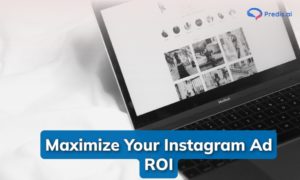Have you ever felt like acquiring fresh clients online was a never-ending struggle against endless competitors? Individuals have more options now than ever, and the competition for their attention is intense.
In fact, 75% of patients use the web to research physicians, dentists, and other healthcare professionals. That implies that having an effective digital presence is no longer optional; it’s a need. But with so much social media noise, where do you even begin?
So, if you want to use social media to gain meaningful change, you have arrived at the right place.
We’ll face the strong competition that lies ahead, guiding you through the plan for reaching your target audience. Furthermore, we will also focus on healthcare social media strategy and demonstrate how to produce compelling material that helps and inspires your patients.
So, prepare to take your healthcare social media strategy to the next level!
The Power of Healthcare Social Media Strategy in Healthcare
In 2024, every person is technologically savvy and expects information to be available at their fingertips. Social media has grown into an integral part of our everyday lives. People use it for various purposes, including checking with friends to discover new recipes.
Unsurprisingly, people also rely on these channels for health information. They look at various issues, including anxiety management and medications for weight loss.
In fact, 65% of individuals check for information on Google before going to the doctor. And it is not limited to traditional search engines. YouTube videos are increasingly popular sources of health knowledge. In addition, social media influencers give much-needed health information. This emphasizes an important point: individuals seek health information online.
This shift in consumer behavior creates an excellent opportunity for healthcare providers to leverage healthcare social media strategy. For example, medical transport providers often showcase their use of NEMT billing software to demonstrate accuracy in claims and efficiency in patient services. By utilizing social media, you may establish yourself as a reliable source of information for this digital generation. Here’s how a robust social media presence might help your practice:
- It allows you to have authentic discussions with your patients. This strengthens ties and encourages patient loyalty.
- Social media marketing is a low-cost strategy for advertising your services and attracting new patients.
- It lets you interact with a much larger audience. By showing your skills online, you can draw in prospective clients from all over.
- You may use engagement data to comprehend your patients’ demographics, hobbies, and even healthcare requirements. This helps you adapt your content and services to better meet their needs.
Social media is the new stethoscope; listen to your patients and establish a flourishing online practice!
Setting the Stage: Goals and Objectives
Next, we’ll look at the techniques for creating engaging social media content that fascinates your audience. While it’s an exciting journey, defining your strategy upfront is crucial for success. Here are the key steps to get started:
1. Defining Goals and Objectives
Every great healthcare social media strategy begins with well-defined goals, whether you’re developing campaigns in-house or partnering with pharma marketing agencies to ensure regulatory compliance. Your objectives function as a guiding beacon. They guarantee that your efforts provide measurable results. Here are some questions you might ask yourself to determine your goals:
- How can I acquire prospective patients online?
- How can I increase my practice’s visibility?
- How can I strengthen my ties with my patients?
- How can I properly communicate important health information?
- How can I maintain my internet visibility and reputation?
By thinking about these questions, you can choose the critical purpose that will lead your social media approach.
Consider the Mount Sinai Health System’s Instagram page, for example. Their social media team described their primary purpose as providing helpful health information. So, they decided to create a content strategy centered on engaging forms. This may involve:
- Inspirational Stories: Using patient success stories to inspire and connect with viewers.
- Health Recommendations: Sharing fast, practical recommendations in easily accessible media such as infographics.
- Interactive Content: Using quizzes, polls, or live Q&A sessions to create interaction and keep viewers interested.
This case exemplifies a clear social media goal of giving helpful health information. A clinic’s social media can play a vital role in this by consistently sharing credible, easy-to-understand health tips, awareness campaigns, and patient-centric updates. This aim may be transformed into a specific content strategy that utilizes engaging formats for success.
2. Identifying Your Target Audience
Understanding your target audience is paramount to crafting impactful social media content. Here are some critical considerations for identifying your ideal patients:
| Target Audience | Interests | Platforms & Habits |
| Young Parents | Healthy recipes, managing child health | Facebook groups, health blogs |
| Busy Professionals | Quick health tips, stress management | Social media (short format), health news apps |
| Fitness Enthusiasts | Training routines, healthy meals | Fitness social media (Instagram, YouTube), fitness blogs |
| Health-Conscious Individuals | Preventative care, healthy living | Health blogs, social media (credible sources) |
| Chronic Illness Patients | Disease management, support groups | Disease forums, social media groups, healthcare websites |
| Seniors | Age-related health, staying active | Senior social media (Facebook), online communities, audio health information |
Choosing the Right Social Media Platform for Healthcare
With a clear understanding of your goals and target audience, it’s time to explore the vast social media landscape. Each platform offers unique advantages for healthcare providers. Here’s a closer look at some of the major players:
1. Healthcare Social Media Strategy Using Facebook
For our first social media platform, let’s look into Facebook. The social media giant provides immense potential for healthcare providers.
According to a study, 40% of people rely on social media for health information; of those, 94% turn specifically to Facebook! That translates to a massive audience you can tap into.
However, Facebook audiences differ from other platforms. They tend to be more receptive to longer-form content like informative articles or engaging videos. Here’s what you can leverage on Facebook:
- Share valuable health information in detailed, well-researched articles.
- Showcase success stories to build trust and inspire your audience.
- Engage directly with patients and address their concerns in real-time.
- Promote a sense of community by creating dedicated groups for patients to connect and support each other.
Check out how you can use Predis.ai’s FB post creator to create informative and inspiring content for your patients seamlessly.
To grasp all of this, consider Facebook’s power over healthcare practitioners. Consider the Johns Hopkins Medicine Facebook page.
Their educational blogs, such as one about five protein-rich foods, offer helpful, practical health advice, establishing them as a reliable source. This increases involvement since patients may share their recipes.
Aside from static postings, Johns Hopkins uses Facebook Reels, which are short, compelling videos. Check out this reel, which focuses on music therapy. This tactic helps to capture attention, create interest in a service, and demonstrate their original approach.
When utilized effectively, Facebook’s capabilities allow healthcare practitioners to engage with patients while solidifying their expertise.
2. Healthcare Social Media Strategy Using X (formerly Twitter)
It is a platform designed for healthcare practitioners to communicate quickly and effectively, and it may be a good fit for your social media strategy.
- X relies on succinct and helpful messaging. Share health recommendations, industry news, or patient success stories in an engaging way that is convenient for busy users.
- X is all about conversations. Respond to patient questions, join pertinent healthcare hashtags, and develop a feeling of community through brief conversations.
Let’s look at Detroit Medical Center’s X approach.
Their initial article on the Type 2 diabetes quiz is right on—it’s all about presenting essential health information in a short, entertaining format. It’s like dispensing bits of health advice that anybody skimming through can pick up on.
Then there is the #BetterTogether hashtag. They use it to honor collaboration in healthcare, such as tales about patients and physicians working together to improve health outcomes.
DMC understands how to utilize X to engage with others, making each tweet useful and community-focused.
Stand Out on Instagram with AI Content 🌟
3. Healthcare Social Media Strategy Using Instagram
Let us set things up for Instagram, the aesthetically pleasing social networking site. Did you know that Instagram’s healthcare engagement is growing, with healthcare-related posts receiving over 4.5 billion monthly likes?
That’s a large audience for healthcare professionals to communicate with visually attractively.
Remember, Instagram consumers are more responsive to visual material than Facebook and X. Here’s how to use Instagram’s power:
- Break down complicated health information into visually appealing infographics that are simple to comprehend and share.
- Showcase patient success stories, showcase less invasive procedures, or provide fast fitness tutorials in an engaging video style.
- Give a sneak glimpse inside your practice! Show off your cutting-edge equipment, introduce your pleasant staff, or showcase a typical day in the life of a doctor – all with fascinating photographs and anecdotes.
Have a closer look at Seattle Children’s Hospital’s Instagram page! Their posts tell a compelling story.
One uplifting example is an inspiring tale about a young patient who overcame a problem. Sharing these victories not only evokes emotions but also highlights the wonderful work their staff performs.

They also use Instagram Reels, which are short, compelling videos. Look at this Reel featuring childhood cancer survivors.
This style is emotionally engaging, generates awareness for their cause, and presents them as a source of hope for other families experiencing similar circumstances.

Short on time but want to create eye-catching health videos for Instagram? Predis.ai’s Instagram Reel maker can help you create engaging content in no time.
4. Healthcare Social Media Strategy Using LinkedIn
Let’s change directions to LinkedIn, the professional networking giant. Consider it an internet platform for establishing oneself as a thought leader in healthcare.
The key to LinkedIn is authoritative content. Unlike other sites, it focuses on exhibiting your professional expertise rather than providing timely updates. Here’s how you can use LinkedIn’s strengths:
- Share your research results, industry perspectives, or novel methods for patient care.
- Participate in relevant healthcare organizations, provide professional thoughts on current issues, and network with peers.
- Have you won an award or published a revolutionary study? Share your successes to establish your reputation.
Take a leaf from Kaiser Permanente’s LinkedIn strategy! They showcase their innovative approach in a post on their cancer clinical trials program. This demonstrates their dedication to innovation and establishes them as leaders in patient care.
By adequately utilizing LinkedIn, Kaiser Permanente presents itself as a trusted expert in the healthcare industry.
Creating LinkedIn posts is now easier than ever. Harness the power of Predis for LinkedIn to generate compelling posts and elevate your professional brand.
5. Healthcare Social Media Strategy Using YouTube
YouTube, the video-sharing powerhouse, should not be disregarded! Health-related YouTube videos have 16 billion views every month, leading to a vast audience for healthcare practitioners who want to educate and interact with patients through compelling video content.
The trick here is to understand YouTube visitors. They frequently want detailed information, so high-quality, useful material is required. Here’s a way you can capitalize on YouTube’s influence:
- Break down complicated medical concepts into explicit, succinct films ideal for people seeking further explanations about treatments like sublingual semaglutide and other advanced therapeutic options.
- Share success stories to personalize your practice. Allow patients to share their stories to foster trust and inspire others.
- Organize interactive sessions with healthcare specialists, where viewers may ask questions and receive real-time replies.
- Use appealing animations to describe medical procedures or disease processes understandably.
If you want to simplify content creation, try Predis.ai’s YouTube Shorts Maker, which lets you create informative health videos quickly.
Let’s explore YouTube for healthcare practitioners. Consider Cigna Healthcare, for example. In its helpful “Stress Care” video series, Cigna addresses a prevalent issue: stress. These concise explanations and practical advice appeal to viewers looking for solutions, establishing Cigna as a reliable source.

Furthermore, Cigna emphasizes their patient attention with movies illustrating their dedication to providing an outstanding client experience. This openness fosters trust and establishes them as a partner in wellness. Cigna’s quality content educates, connects, and helps it become a YouTube success story.

Best Practices for Healthcare Social Media Strategy
Now that you’ve covered the fundamentals of creating a healthcare social media strategy let’s look at some best practices for increasing your impact:
- Short wellness advice on X or Facebook engages busy followers.
- Explainer videos on YouTube can help patients look for in-depth explanations of complicated issues.
- Showcase success stories on Instagram or Facebook to gain trust and motivate others.
- Organize interactive sessions on any platform to address real-time patient inquiries.
- Technical health information gets clear and shared on Instagram and Facebook.
- Give your practice a little personality on Instagram or Facebook by showing off your team, equipment, or a typical doctor’s day.
- This diversity engages your readers and portrays you as a comprehensive healthcare resource.

Conclusion
These healthcare social media strategies for healthcare practitioners may have piqued your interest in their possibilities. Remember that social media is about more than simply distributing medical knowledge; it’s also about creating meaningful connections with your target audience.
Healthcare providers should establish a solid social media presence that informs, empowers, and inspires by carefully using the different characteristics of multiple platforms. So, embrace the power of social media and set out on a quest to interact with your patients in a completely new way.
Are you feeling stressed out by social media content? Predis.ai can be your partner! They can help you create engaging content. Check out the live demo to win on social media!
Related Content,























